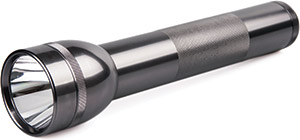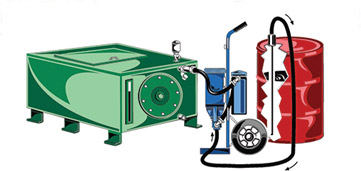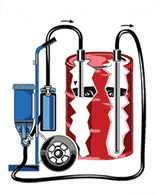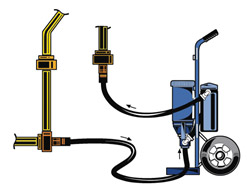How to Equip Lube Techs for Success
 Are you a lubrication technician (lube tech), oiler or lubricator? Are you responsible for performing lubrication tasks for your company, such as topping up machines with oil, regreasing bearings or even determining if a machine might have a potential health issue? If so, you have a direct influence on how lubricated machines are maintained. But are you equipped with the right tools and skills to perform this job effectively? The following tools of the trade are what world-class lubrication programs have readily available.
Are you a lubrication technician (lube tech), oiler or lubricator? Are you responsible for performing lubrication tasks for your company, such as topping up machines with oil, regreasing bearings or even determining if a machine might have a potential health issue? If so, you have a direct influence on how lubricated machines are maintained. But are you equipped with the right tools and skills to perform this job effectively? The following tools of the trade are what world-class lubrication programs have readily available.
Essentials for Machine/Lubricant Inspections
One of the most important jobs for any lube tech is making smart inspections, and specific tools will be required for this task to be done correctly. A quality flashlight is a simple but essential tool that can be used to inspect the lubricant through a sight glass, level gauge or bottom sediment and water (BS&W) bowl. A strong flashlight not only will enable you to verify the oil level but also to visually analyze the fluid for solid contamination, wear debris, water, color change or other unusual signs.
The design of the sight glass plays a role as well. The best option is a protruding (3-D) design that allows the flashlight to illuminate from one side of the glass to the other. It is also crucial that the flashlight shine through without a significant amount of refracted light.
Various types of flashlights and optical viewing aids may be able to provide other advantages for machine and lubricant inspections. These include a blue-light LED flashlight, a laser pointer, a borescope, a quality camera with a flash, an oil color gauge, pipettes, a telescoping magnet, a telescoping mirror and a spatula to inspect grease consistency.
 Being able to view the oil in a machine through a sight glass is necessary because it’s not practical to take frequent oil samples in most cases. When a sample is collected, it is imperative to examine the oil in the bottle to quickly determine if any action should be taken.
Being able to view the oil in a machine through a sight glass is necessary because it’s not practical to take frequent oil samples in most cases. When a sample is collected, it is imperative to examine the oil in the bottle to quickly determine if any action should be taken.
Of course, there are many ways to inspect an oil sample other than through a visual inspection. Measuring the temperature of the machinery can be very useful in indicating potential issues. If a machine does not already have an oil temperature monitor, a simple temperature gun or thermal camera can provide a quick reading. This should be part of the machine’s inspection route, especially for critical assets or those with a history of overheating.
Effective Oil Sampling and Quick Oil Analysis
 Taking a representative oil sample requires specific sampling hardware and tools, including a vacuum sampler, plastic tubing, certified clean bottles, sample bottle labels, a sample probe adapter, zip-lock bags, a lint-free cloth and a written procedure. Once the sample is obtained, a quick visual inspection of the lubricant should be performed by the lube tech. Shining a strong laser through the oil will illuminate small particles and any evidence of entrained air or emulsified water.
Taking a representative oil sample requires specific sampling hardware and tools, including a vacuum sampler, plastic tubing, certified clean bottles, sample bottle labels, a sample probe adapter, zip-lock bags, a lint-free cloth and a written procedure. Once the sample is obtained, a quick visual inspection of the lubricant should be performed by the lube tech. Shining a strong laser through the oil will illuminate small particles and any evidence of entrained air or emulsified water.
After the initial visual inspection, the oil sample should be kept still for an hour or more. Another visual inspection can then be made to shed light on any water separation or particle accumulation at the bottom. A magnet may also be utilized to determine if the particles are ferrous in nature, which likely would indicate wear debris.
While oil samples will need to be sent to a well-equipped laboratory, it is beneficial to have certain types of instruments onsite for quick oil analysis. The most common onsite instruments are a patch test kit with a comparator, a viscometer, a particle counter, a hot plate with a dimmer switch, a magnet for quick ferrous-density inspection, a Schiff’s reagent test, a laser light for debris inspection, acid and base number test kits, and portable water testers.
Filter Cart Applications
 Power Flush — This involves reducing the oil level in the tank or sump and flowing oil at a high velocity across the bottom to push out low-lying sediment.
Power Flush — This involves reducing the oil level in the tank or sump and flowing oil at a high velocity across the bottom to push out low-lying sediment.
 Wand Flush — A wand is attached to one of the cart hoses and is used first to discharge at high pressure (kicking up adherent debris). Then the flow is reversed, and the wand vacuums the sediment.
Wand Flush — A wand is attached to one of the cart hoses and is used first to discharge at high pressure (kicking up adherent debris). Then the flow is reversed, and the wand vacuums the sediment.
 Transfer Cart — Oil is transferred from a storage container (tote, drum, etc.) to the machine’s lube compartment.
Transfer Cart — Oil is transferred from a storage container (tote, drum, etc.) to the machine’s lube compartment.
 Cleaning Stored Lubes — In this application, the cart multipasses fluid out of and back into the drum or tote to draw down contamination.
Cleaning Stored Lubes — In this application, the cart multipasses fluid out of and back into the drum or tote to draw down contamination.
 System Drain — Sump and reservoir drains will wash out debris better if the waste oil is pumped out as opposed to simply flowing out by gravity.
System Drain — Sump and reservoir drains will wash out debris better if the waste oil is pumped out as opposed to simply flowing out by gravity.
 Line Flush — Remote lines and components often need to be partitioned to enable flushing. This can be done easily with a filter cart.
Line Flush — Remote lines and components often need to be partitioned to enable flushing. This can be done easily with a filter cart.
 Hose Cleaning — Before new hoses are installed on a machine, they can be flushed of debris using a filter cart.
Hose Cleaning — Before new hoses are installed on a machine, they can be flushed of debris using a filter cart.
Off-line Filtration — Filter carts can be mounted permanently to a machine to supplement filtration.
Repairs and Equipment Rebuild Flushing — After machines are serviced, they need to be flushed thoroughly before they are returned to service.
Flushing During Equipment Commissioning — New machines have original fabrication debris and dirt that have ingressed during transport and storage.
Contamination Control and Lubricant Application Tools
A well-designed lube room will incorporate special tools for promoting contamination control even before the oil reaches the machine. These include sealable and refillable top-up containers, grease guns dedicated to a single lubricant, a parts-cleaning station, posted procedures for all lubrication tasks, cleaning tools, and identification labels for all devices in contact with oil.
A filter cart is another valuable tool for contamination control. It can be used in a number of ways, which are detailed in the sidebar on the right.
Safety Equipment and Training
Safety equipment could be considered a lube tech’s most important tools. The standard personal protection equipment includes earplugs, safety glasses, hard hats, steel-toe boots and special clothing to protect against potential hazards. Depending on the job, other safety items may be necessary, such as gloves, breathing masks, etc.
Safety training is another common requirement for any plant activity including lubrication. However, for lube techs, the training should go beyond just safety. Machine maintenance, whether it is proactive, predictive or preventive, can be complicated. Lubrication training should be obtained and based on the tasks that will be performed. This type of training often results in beneficial certifications, such as the Machine Lubrication Technician (MLT) and Machine Lubricant Analyst (MLA) certifications from the International Council for Machinery Lubrication (ICML).
Other Tools
Multi-tools or shop tools like a torque wrench are basic essentials for any technician. Even utilizing a toolbelt can provide conveniences that will improve job performance.
Regardless of your title, if you are not equipped with the proper tools to perform your job effectively, it is time you considered making an investment.
Machinery Lubrication Reference Guide
Packed with useful checklists, look-up tables, charts and illustrations, the Machinery Lubrication Reference Guide is designed to make information easily accessible where you need it – in the field, on your desk or in your pocket. Lube techs can use it as a handy on-the-job reference or as a study aid for certification exams. For more information, visit the Noria Bookstore at store.noria.com.

